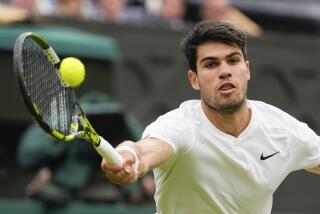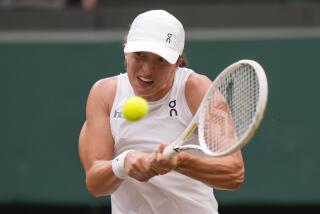Women’s Tour Feels Some Pain
As the incredible shrinking women’s tennis tour makes its way to Indian Wells for the Pacific Life Open, the WTA logo should feature a player holding a crutch instead of one holding a racket.
The $2.1-million, Tier I tournament, which starts with main-draw play today at the Indian Wells Tennis Garden, is without six of the top 10 ranked players in the world. Missing are No. 3 Amelie Mauresmo of France, No. 6 Jennifer Capriati, No. 7 Serena Williams, No. 8 Elena Dementieva of Russia and No. 10 Ai Sugiyama of Japan. And on Tuesday night, No. 9 Chanda Rubin was forced to pull out because of inflammation in her left knee, which has kept her out since late January.
Even some players on the next level will be missing the event for various reasons, including No. 15 Silvia Farina Elia of Italy, No. 17 Venus Williams and No. 18 Patty Schnyder of Switzerland.
But Indian Wells should not be feeling picked on.
So far in 2004, Capriati, because of an aching back, has played in only two tournaments and missed the first Grand Slam, the Australian Open in January. Serena Williams, recovering from knee surgery, has not stepped on the court for a match since July at Wimbledon, and an injury-riddled Venus Williams has played only six matches. Mauresmo’s back injury was so severe, she could not play her quarterfinal match in Melbourne.
They’re not up to it, but the Williams sisters would not have shown up at Indian Wells even if they had been 100%. They have not been back since 2001, when they were booed a couple of days after Venus had withdrawn a few minutes before a scheduled night semifinal match against Serena because of a knee injury.
Even the usually reliable Kim Clijsters of Belgium, the defending champion at Indian Wells and seeded second this year behind countrywoman Justine Henin-Hardenne, fell victim to the curious curse, spraining her ankle at the Hopman Cup in Perth, which forced her to pull out of the WTA Tour stop the next week in Sydney.
Larry Scott, the WTA’s chief executive, said he hadn’t detected any particular trend regarding the injuries and wasn’t hitting the panic button.
WTA officials said there were no more injuries than last year at this time and that many were the results of something other than overplaying. Venus and Serena Williams, for a couple of instances, played a combined total of 13 tour events in 2003, well below the usual number for one top player, let alone two.
“That is the question I’ve been asked the most, if I know the reason why everyone is injured,” Clijsters said. “Again, at the end of last year or the middle of last year, people were getting a little bit injured as well. And Venus and Serena started pulling out.
“And [reporters] started asking me, ‘Is the schedule too tough?’ I don’t know what the reason is. Maybe it’s because they are not preparing well enough for the start of the year to play a lot matches in a row, or is it because they have worked too hard in the off-season and their bodies are already tired?”
Clijsters joked about the run of misfortune.
“What happened to me was an accident,” she said. “I’m sure maybe there is a spell going around.”
The situation probably seems worse because it involves top players. The last time No. 1 Henin-Hardenne, Clijsters, Serena and Venus Williams were all in the same tournament was at Wimbledon.
“You need those big matches to keep you going,” Clijsters said. “That is something that I definitely miss. I miss the matches against Venus and Serena as well.”
In the meantime, the tour has taken a small step toward more control over where players are scheduled to participate by establishing a designation for those on the WTA’s gold exempt list, essentially the top 20 players. Scott said the tour could change one event to another for each player on the list.
“The idea behind that is to try to create balanced fields by tier level, to make sure it’s an even spread of players to tournaments of different tiers,” Scott said. “ ... I’m certainly a proponent of the tour having some more control over where players play, finding a better balance between allowing free choice to having some control and consistency over the quality of the player fields.”
*
The toughest quarter appears to be the section featuring Henin-Hardenne and No. 12 Svetlana Kuznetsova of Russia. Kuznetsova ended Henin-Hardenne’s 16-match winning streak last week in Doha and beat Venus Williams the week before in Dubai. Rubin had been in that section of the draw, but Amy Frazier was moved to that spot.
Last year’s finalists, Clijsters and No. 3 Lindsay Davenport, are in the same half and could meet in the semifinals. One of the best potential fourth-round matches could feature No. 4 Anastasia Myskina of Russia against No. 16 Maria Sharapova of Russia. They met in the third round of the Australian Open and Myskina won in three sets.
More to Read
Go beyond the scoreboard
Get the latest on L.A.'s teams in the daily Sports Report newsletter.
You may occasionally receive promotional content from the Los Angeles Times.











